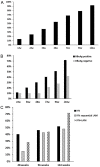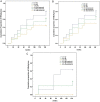Clinical Predictors of Functional Cure in Children 1-6 Years-old with Chronic Hepatitis B
- PMID: 35836765
- PMCID: PMC9240240
- DOI: 10.14218/JCTH.2021.00142
Clinical Predictors of Functional Cure in Children 1-6 Years-old with Chronic Hepatitis B
Abstract
Background and aims: Hepatitis B surface antigen (HBsAg) clearance is significantly more common in children with chronic hepatitis B (CHB) than in adults; however, the possible influencing factors related to HBsAg loss have yet to be found. This study aimed to explore the efficacy of long-term interferon (IFN)α therapy in treating children with CHB and analyzed the factors influencing functional cure after treatment.
Methods: A total of 236 children aged 1-6 years and diagnosed with CHB via liver biopsy were included in the study, all receiving IFNα treatment (IFNα-2b monotherapy, IFNα-2b followed by lamivudine [LAM] or IFNα-2b combined with LAM) and followed up for 144 weeks. A comprehensive analysis was conducted on clinical data, including biochemical items, serum markers of hepatitis B virus (HBV) and immunological indexes, and logistic regression analysis was used to screen the influencing factors related to HBsAg loss.
Results: The cumulative loss rates of HBsAg were 79.5%, 62.1% and 42.1% at 144 weeks after the start of treatment in the 1-3 years-old group, 3-5 years-old group and 5-7 years-old group, respectively (p<0.05). IFNα-2b combined with LAM treatment displayed the highest HBsAg loss rates compared with monotherapy and sequential treatment (p=0.011). Younger baseline age and lower HBsAg levels were independent factors for the prediction of HBsAg loss (p<0.05). The baseline PreS1 and hepatitis B core antibody levels in the HBsAg loss group were lower than those in the HBsAg non-loss group. In addition, the PreS1 level was positively corelated with the level of HBsAg, HBV DNA and liver inflammation.
Conclusions: Long-term treatment with IFNα was effective in achieving HBsAg loss in CHB children aged 1-6 years-old. Age less than 3 years-old and lower HBsAg levels are independent predictors of functional cure in children with CHB.
Keywords: Children; Chronic hepatitis B; Lymphocytes; Predictors; Therapeutic efficacy; interferon, IFN.
© 2022 Authors.
Conflict of interest statement
The authors have no conflict of interests related to this publication.
Figures


Similar articles
-
Peginterferon alpha-based therapy for chronic hepatitis B focusing on HBsAg clearance or seroconversion: a meta-analysis of controlled clinical trials.BMC Infect Dis. 2011 Jun 9;11:165. doi: 10.1186/1471-2334-11-165. BMC Infect Dis. 2011. PMID: 21651820 Free PMC article.
-
[A randomized controlled study on factors influencing the curative effect of sequential combined interferon and lamivudine therapy in children with immune-tolerant phase chronic hepatitis B].Zhonghua Gan Zang Bing Za Zhi. 2019 Aug 20;27(8):604-609. doi: 10.3760/cma.j.issn.1007-3418.2019.08.004. Zhonghua Gan Zang Bing Za Zhi. 2019. PMID: 31594077 Clinical Trial. Chinese.
-
Systematic review and meta-analysis: de novo combination of nucleos(t)ide analogs and pegylated interferon alpha versus pegylated interferon alpha monotherapy for the functional cure of chronic hepatitis B.Front Pharmacol. 2024 Jul 5;15:1403805. doi: 10.3389/fphar.2024.1403805. eCollection 2024. Front Pharmacol. 2024. PMID: 39035984 Free PMC article.
-
Quantification of HBsAg and HBV-DNA during therapy with peginterferon alpha-2b plus lamivudine and peginterferon alpha-2b alone in a German chronic hepatitis B cohort.Z Gastroenterol. 2011 Nov;49(11):1463-9. doi: 10.1055/s-0031-1281582. Epub 2011 Nov 8. Z Gastroenterol. 2011. PMID: 22069045 Clinical Trial.
-
HBeAg-negative chronic hepatitis B: why do I treat my patients with pegylated interferon-alfa?Liver Int. 2014 Feb;34 Suppl 1:127-32. doi: 10.1111/liv.12404. Liver Int. 2014. PMID: 24373089 Review.
Cited by
-
Functional cure is associated with younger age in children undergoing antiviral treatment for active chronic hepatitis B.Hepatol Int. 2024 Apr;18(2):435-448. doi: 10.1007/s12072-023-10631-9. Epub 2024 Feb 20. Hepatol Int. 2024. PMID: 38376650 Free PMC article.
-
Functional Cure of Chronic Hepatitis B with Antiviral Treatment in Children having High-level Viremia and Normal or Mildly Elevated Serum Aminotransferase.J Clin Transl Hepatol. 2023 Oct 28;11(5):1011-1022. doi: 10.14218/JCTH.2023.00014. Epub 2023 Apr 10. J Clin Transl Hepatol. 2023. PMID: 37577220 Free PMC article.
-
Functional cure of a young child with chronic hepatitis B cirrhosis treated by pegylated interferon α combination therapy: A case report.Medicine (Baltimore). 2025 Jan 10;104(2):e41103. doi: 10.1097/MD.0000000000041103. Medicine (Baltimore). 2025. PMID: 39792754 Free PMC article.
-
Achieving chronic hepatitis B functional cure: Factors and potential mechanisms.Virus Res. 2025 Jan;351:199507. doi: 10.1016/j.virusres.2024.199507. Epub 2024 Dec 13. Virus Res. 2025. PMID: 39662778 Free PMC article.
-
Predictive value of HBeAg titer dynamics for HBsAg clearance in pediatric chronic hepatitis B.Front Pediatr. 2025 Apr 3;13:1539300. doi: 10.3389/fped.2025.1539300. eCollection 2025. Front Pediatr. 2025. PMID: 40248021 Free PMC article.
References
LinkOut - more resources
Full Text Sources
